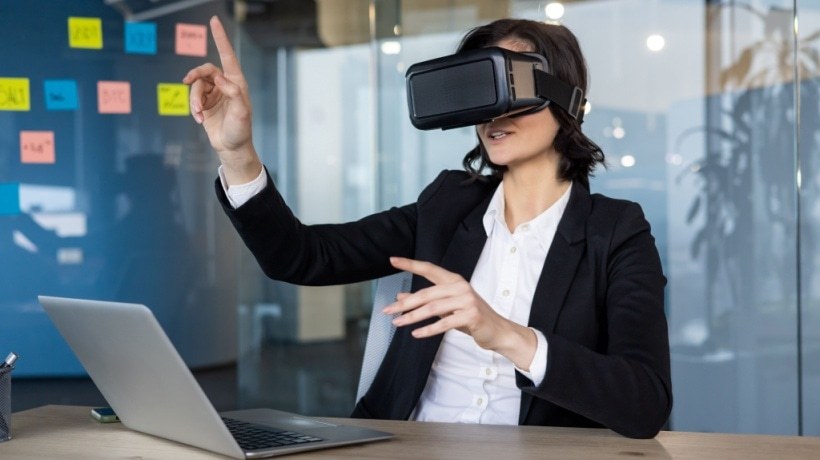Benefits Of VR In Corporate Training
Virtual Reality (VR) is reshaping how organizations train their workforce, offering a blend of immersion, interactivity, and realism that traditional methods cannot match. By transporting learners into a simulated environment, VR allows employees to engage with lifelike scenarios, practice skills, and make decisions in a risk-free setting. As companies strive to enhance productivity and stay competitive, VR is emerging as a transformative tool in corporate training. In this article, we’ll explore various use cases of VR in corporate training and how it addresses specific challenges while delivering measurable results.
Use Cases For VR In Corporate Training
Enhancing Employee Onboarding With VR
The onboarding process is crucial for acclimating new employees to a company’s culture, values, and operations. However, conventional methods, such as lengthy presentations and static manuals, often fail to engage new hires effectively. VR revolutionizes onboarding by providing interactive and visually rich experiences. For example:
- Virtual office tours
New hires can explore office layouts and facilities virtually, even before stepping into the workplace. - Role-specific training
Employees can immerse themselves in virtual scenarios tailored to their job responsibilities, giving them a head start. - Cultural immersion
VR can simulate interactions with virtual colleagues, helping employees understand workplace dynamics and expectations.
These immersive experiences not only reduce the time taken to onboard employees but also enhance their confidence and readiness.
Simulating Real-World Scenarios Safely
Certain industries, such as construction, healthcare, and manufacturing, involve high-risk tasks where mistakes can lead to severe consequences. VR provides a safe and controlled environment for employees to practice and master these tasks without endangering themselves or others. Examples include:
- Safety drills
Workers can experience virtual fire drills, machinery malfunctions, or chemical spills, learning to respond effectively. - Emergency preparedness
Healthcare professionals can simulate life-saving procedures, honing their skills under virtual pressure. - Operational training
Employees can practice operating heavy machinery or complex systems in a risk-free virtual setting.
By simulating real-world scenarios, VR minimizes risks while maximizing preparedness and confidence.
Improving Soft Skills Through VR Training
Soft skills such as communication, teamwork, and emotional intelligence are essential for success in any organization. However, developing these skills through traditional training methods can be challenging. VR offers a dynamic solution by creating immersive role-playing scenarios that mimic real-world interactions. For instance:
- Customer service training
Employees can engage with virtual customers, handling complaints, queries, and feedback. - Leadership development
Managers can practice decision-making, conflict resolution, and team management in simulated environments. - Diversity and inclusion training
VR can simulate diverse workplace scenarios, helping employees understand and address unconscious biases.
This interactive approach builds confidence, fosters empathy, and enhances employees’ ability to handle real-life situations effectively.
Boosting Technical Training With VR
Technical training often involves complex procedures, expensive equipment, and safety concerns. VR eliminates these barriers by enabling hands-on practice in a virtual environment. Key applications include:
- Software training
Employees can learn to use complex software systems through guided virtual tutorials. - Machinery operation
Workers can practice operating machinery without risking damage or downtime. - Product development
Engineers and designers can interact with 3D models of products, testing functionality and identifying improvements.
With VR, employees can learn at their own pace, repeat sessions as needed, and gain confidence in their technical skills.
Compliance Training Made Engaging With VR
Compliance training is essential for ensuring that employees adhere to industry regulations and company policies. However, it is often perceived as monotonous and uninspiring. VR transforms compliance training into an engaging and impactful experience. Examples include:
- Ethics training
Employees can navigate ethical dilemmas in a virtual setting, learning to make decisions aligned with company values. - Regulatory compliance
Workers can simulate scenarios that require adherence to safety, data protection, or financial regulations. - Anti-harassment training
VR can create realistic workplace scenarios to help employees identify and address inappropriate behavior.
By making compliance training interactive and immersive, VR ensures better retention and application of critical knowledge.
Benefits
The use of VR in corporate training offers several advantages, including:
- Enhanced engagement
Immersive experiences captivate learners and maintain their focus. - Improved retention
Interactive simulations reinforce learning, leading to better knowledge retention. - Cost savings
VR reduces the need for physical resources, travel, and on-site trainers. - Scalability
VR training programs can be deployed across multiple locations, ensuring consistency. - Data-driven insights
VR systems can track employee performance, providing valuable insights for improvement.
Challenges And Future Of VR In Training
While VR offers significant benefits, its adoption is not without challenges:
- High initial costs
Developing VR content and acquiring hardware can be expensive. - Technical limitations
VR requires robust infrastructure and may face compatibility issues. - Learning curve
Employees and trainers may need time to adapt to VR systems.
Despite these challenges, advancements in VR technology and decreasing costs are making it more accessible. The future of VR in corporate training looks promising, with potential applications in AI integration, remote collaboration, and personalized learning.
Conclusion
Virtual Reality is transforming corporate training by offering innovative solutions for onboarding, skill development, compliance, and more. Its ability to create immersive and engaging learning experiences is unmatched, making it a valuable investment for organizations looking to enhance employee performance and productivity.
By embracing VR, companies can stay ahead of the curve, equipping their workforce with the skills and knowledge needed to thrive in a competitive landscape. As technology continues to evolve, the possibilities for VR in corporate training are virtually limitless.
Ozemio
We recognise the value of something so simple, yet elemental – that transformation doesn’t take place in silos. Our talent transformation solutions are holistic, yet targeted. We offer tailor made plans that are specific to your business requirements

